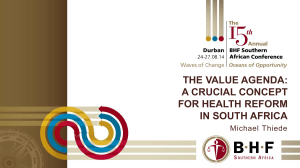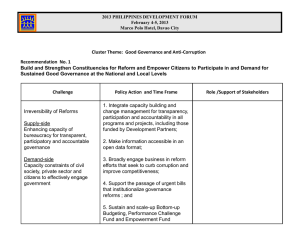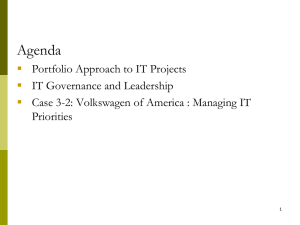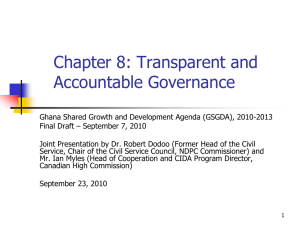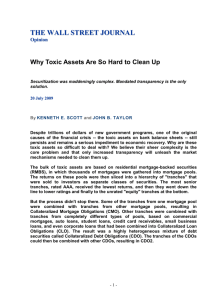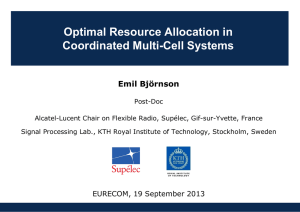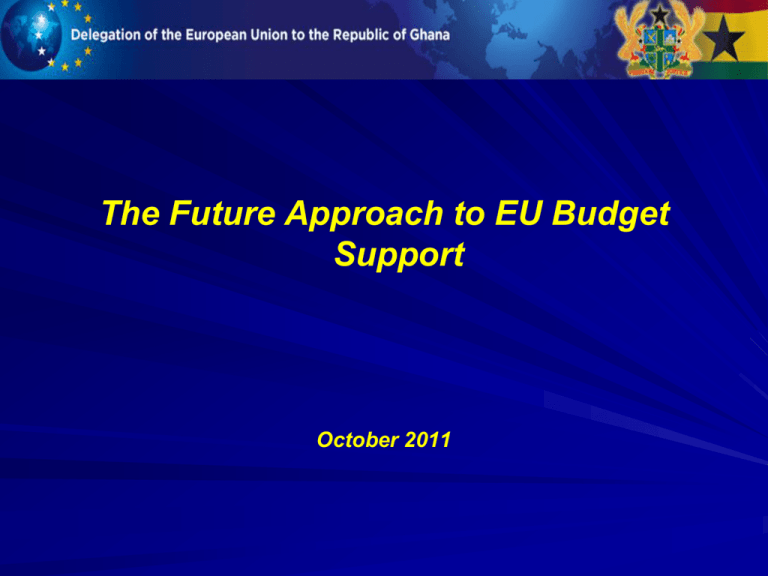
The Future Approach to EU Budget
Support
October 2011
Summary
Main messages
•
•
•
•
•
•
•
•
Continued importance of budget support instrument
Stronger link with fundamental values of the EU (human rights,
democracy and rule of law)
Greater differentiation of budget support operations, allowing the EU
to respond better to the political, economic and social context of the
partner country
Strengthened eligibility criteria and more rigorous assessment
Stronger focus on accountability and transparency
Strengthened risk management framework
Continued emphasis on results, performance tranches, government
ownership and predictability
Strengthened EU Coordination
Communication- Outline
1. What is Budget Support, and Why
2. A Modern Approach to Budget Support
3. EU Coordinated Approach
4. Design and Implementation
5. Conclusions
What is Budget Support, and Why
BS as package: Policy dialogue, financial transfers,
performance assessment and capacity building
Means of delivering better aid (not an end in itself)
Most suitable form of aid consistent with aid
effectiveness agenda
But not a blank cheque, nor provided to every country
Green Paper October 2010 – Wide consultation process
of stakeholders, both from EU and partner countries.
In this Communication, the Commission sets out a new
policy on budget support and puts forward policy
proposals for an EU coordinated approach
Lessons Learned
Positive experiences
OECD-DAC evaluations
Encouraging results from new pilot evaluation
methodology – Tunisia, Mali and Zambia
Budget Support and MDG performance
Scope for Improvement
Court of Auditor findings and recommendations
Calls for greater coherence and consistency of EU
support
Need for more transparency and accountability
A Modern Approach to Budget Support
Building on success
Predictability, ownership, performance related tranches,
results
Use of more intermediate process and output indicators to better
demonstrate and communicate partner country development
results
Dynamic approach to eligibility criteria
But more structured assessment
Portfolio approach: no global targets for use of budget
support
Risk management to be strengthened
A Modern Approach to Budget Support
Differentiating EU Budget Support
Good Governance and Development Contract
Sector Reform Contract
State Building Contract
A Modern Approach to Budget Support
Budget support as a vector of change to address the
following 5 development challenges and objectives:
1.
Promoting human rights and democratic values
Good Governance and Development Contracts should be provided
where there is trust and confidence that aid will be spent pursuing the
values and objectives to which the EU subscribes, and on which partner
countries commit to move towards meeting international standards.
Where commitment deteriorates: adequate and coordinated EU+MS
response, but also progressive and proportionate. Possibility to adjust
fixed tranche
Sector budget support (sector reform contract) remains a useful tool to
address the basic needs of populations even where the conditions do
not exist to permit the use of a Good Governance and Development
Contract.
A Modern Approach to Budget Support
Charter of fundamental rights of the European Union
Everyone has the right to respect for his or her physical and mental
integrity (art. 3)
Prohibition of torture and inhuman or degrading treatment or
punishment (art. 4)
Everyone has the right to respect for his or her private and family life,
home and communications (art. 7)
Everyone has the right to freedom of thought, conscience and
religion (art. 10)
Everyone has the right to freedom of expression (art. 11)
Any discrimination based on any ground such as sex, race, colour,
ethnic or social origin, genetic features, language, religion or belief,
political or any other opinion, membership of a national minority,
property, birth, disability, age or sexual orientation shall be prohibited
(art. 21)
A Modern Approach to Budget Support
2.
Improving PFM, macroeconomic stability, inclusive growth and
the fight against corruption and fraud
Budget support, in particular Good Governance and Development
Contracts, should be used to strengthen core government systems,
such as public finance management and public administration
Promote macroeconomic stability and fiscal sustainability, making the
systems more effective and accountable and lead to a comprehensive
and transparent budgetary allocation process.
address constraints on sustained growth and to promote the "green
economy", including the protection and sustainable use of public goods
and natural resources, while ensuring that the benefits of growth are
widely shared.
As part of its objective to improve core government systems, particularly
procurement, budget support will contribute to the fight against
corruption and crimes involving fraud.
A Modern Approach to Budget Support
3.
Promoting sector reforms and improving sector service delivery
Sector Reform Contracts can be provided to a specific sector or a set
of interlinked sectors
Clear objectives should be defined, mainly in terms of improvements in
public access and use of quality services and, in particular in the
neighbourhood countries, support for the partnership agenda
Sector specific conditions should lead to a regular policy dialogue,
including on budgetary allocations to the sector, implementation of
reforms, strengthening of institutions and systems, progress towards
sector objectives, and efficient service delivery.
Emphasis will be on issues relating to frontline service delivery,
particularly pro-poor, gender and children's issues, and the capacity to
absorb and use sector research results.
A Modern Approach to Budget Support
4.
State-building in fragile states, and addressing development
challenges of SIDS and OCTs
Fragile states: focus on state building, coherent and coordinated
approaches, reinforced political and policy dialogue. Decisions case by
case. State Building Contracts
SIDS and OCTs: BS to address cross-cutting, long-term and structural
challenges
5.
Improving domestic revenue mobilisation and reducing
dependency on aid
BS should complement, not substitute, domestic revenue mobilisation
Promote natural resource governance and transparency in resource rich
countries
EU Coordinated approach
Objective
– to increase effectiveness of this modality in contributing to development and
reform policies, and to provide coherent and consistent responses to challenges
encountered
– Work towards a “single EU Good Governance and Development Contract”
– Acting together to increase critical mass and leverage
Key principles
– Sovereign decision making
– systematic information exchange as a minimum, with coordinating responses the
ultimate goal
– EU coordination should always be supportive of wider donor coordination and
country-led co-ordination
– Coordination at both HQ and field level and must build on existing bodies and
mechanisms of cooperation as well as existing legal frameworks.
EU Coordinated approach
Key elements
share initial assessment on commitment of partner country to the EU
fundamental values;
share, where relevant, diagnostics and assessments of eligibility conditions
(but decisions on compliance remain the responsibility of each donor);
harmonize, as far as possible, risk assessment tools and promote a
coordinated dialogue on mitigating actions;
perform joint assessments at country level and regular joint evaluations;
ensure high level of expertise for effective policy dialogue with the partner
countries by using delegated cooperation and transfer arrangements;
carry out high level political dialogue, including monitoring of commitment to
fundamental values and appropriateness of pursuing good governance and
development contract;
jointly communicate to local stakeholders budget support disbursements
and compliance with disbursement conditions.
Design and Implementation
Precondition
EU to assess whether preconditions for Good Governance and Development Contract exist:
Human rights, Democracy and Rule of Law
Eligibility Criteria
Stable macroeconomic framework
National/sector policy and reform
Increased focus on domestic revenue mobilisation
Continued focus on national ownership
Focus on sustainable growth and poverty reduction (link to “Agenda for Change”)
Public financial management
Assessment of PFM system to establish a baseline upon which dynamic approach will be based
May require short-term measures from PFM reform strategy before commencing BS
Partner countries to be actively engaged in fight against fraud and corruption
NEW: transparency and oversight of budget
Public availability of budgetary information
“Entry point” to be defined, combined with dynamic approach
Design and Implementation
Managing Risk
Improved risk management framework
Political governance, macroeconomic, development, PFM, corruption and fraud
Complementary tool in programming, design and implementation, and to inform
decision-making and policy dialogue
Focus on risks with high impact and high likelihood
How Much Budget Support
Financing needs
Budgetary allocations according to policy objectives and priorities
Effectiveness, VFM, and impact
Track record and absorption capacity
Result orientation
Design and Implementation
Policy Dialogue
To ensure that major reforms are discussed and fully resourced, objectives
are identified and results assessed
Involvement of relevant Commission services, delegated cooperation with
MS, improved access to TA and training
Committed to promote inclusion of domestic stakeholders in policy dialogue
and annual reviews
Performance Incentives and Conditions
Base tranches linked to eligibility
Performance tranches linked to progress against indicators (mix of process,
output and outcome indicators)
Good governance and development contracts: conditions may be attached
to supporting democracy and human rights
Design and Implementation
Predictability
Eligibility related conditions to be as clear as possible
Longer term commitments where strong track record, informed by review of
experience with MDG-Contracts (late 2011)
Strengthening domestic and mutual
accountability
Strengthening openness, transparency and accountability of the budget
process
Supporting a participatory budget support approach
Integrating programmes to support national legislative and oversight bodies
and CSOs
Increasing transparency by publishing relevant information on budget
support financing agreements and performance reviews
Design and Implementation
Capacity development
Needs to be identified and assessed systematically as part of BS operations
To be based on demand, linked to clear outputs, harmonised and aligned
initiatives
Monitoring, evaluation and communication
Importance of credible and functioning M&E system and identified actions to
address weaknesses, especially regarding:
Institutional set-up of M&E system
Link between M&E plan and policy development
Quality, regularity and reliability of data
M&E system should contribute to strengthening voice of national
stakeholders
Need better communication of results of evaluations and lessons learned
Conclusions
Communication seeks to
Make budget support more efficient and effective in
delivering development results
Equip the EU and Member States with an “EU
Coordinated Approach” on budget support
New guidelines to reflect guiding
principles


